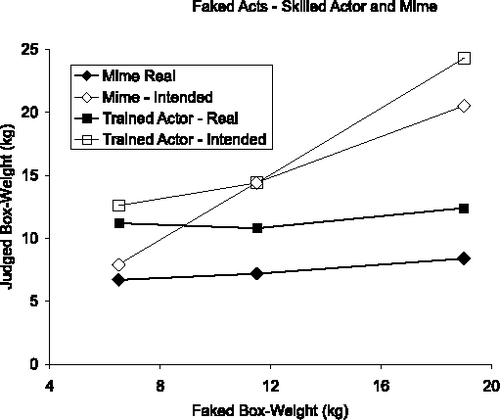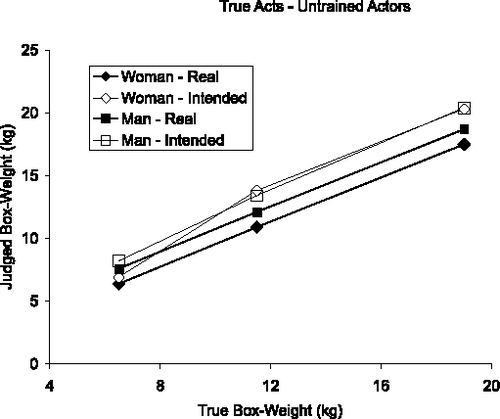Introduction
An error appeared in Ecological Psychology, Volume 19, Issue 2, “Perceiving the Actions of Other People,” by Leonard S. Mark. The text for Figures 4a and 4b, , , and did not correspond with the figures being presented. Corrections for each of these figures appear below. The publisher regrets the error.
FIGURE 4 Mean discomfort rating as a function of reach distance (expressed as a percentage of each actor's maximum seated [arm-and-torso] reach) for two actors from Stasik and Mark's (2005) study. The actors' ratings of their own reach are shown with the unfilled diamonds and the mean ratings for the observers are shown with the filled squares. Observers' judgments of each actor's discomfort closely followed the actor's ratings. Both sets of discomfort judgments increased markedly as the reach distance approached the actor's preferred critical boundary.
![FIGURE 4 Mean discomfort rating as a function of reach distance (expressed as a percentage of each actor's maximum seated [arm-and-torso] reach) for two actors from Stasik and Mark's (2005) study. The actors' ratings of their own reach are shown with the unfilled diamonds and the mean ratings for the observers are shown with the filled squares. Observers' judgments of each actor's discomfort closely followed the actor's ratings. Both sets of discomfort judgments increased markedly as the reach distance approached the actor's preferred critical boundary.](/cms/asset/fe4de5a6-1c21-48bd-8105-e2e394148a11/heco_a_280218_o_f0001g.gif)
FIGURE 5a True acts for skilled actor and mime. Judged weight of the box as a function of the true box weight for the skilled actor and mime. The filled squares show observers' judgments of the actual weight of the box. The unfilled squares show observers' judgments of the intended weight of the box. As in Runeson and Frykholm's studies (1981, 1983), observers were quite accurate in estimating the actual weight of the box being lifted.

FIGURE 5b Faked acts for skilled actor and trained mime. Judged weight of the box as a function of the true box weight for the skilled actor and mime. The filled squares show observers' judgments of the actual weight of the box. The unfilled squares show observers' judgments of the intended weight of the box. As in Runeson and Frykholm's studies (1981, 1983), observers were quite accurate in detecting the actual weight of the box and estimating the intended weight that the actor was trying to portray.

FIGURE 5c True acts for unskilled actors. Judged weight of the box as a function of the true box weight for the unskilled actors. The filled squares show observers' judgments of the actual weight of the box. The unfilled squares show observers' judgments of the intended weight of the box. As in Runeson and Frykholm's studies (1981, 1983), observers were quite accurate in estimating the actual weight of the box being lifted.
